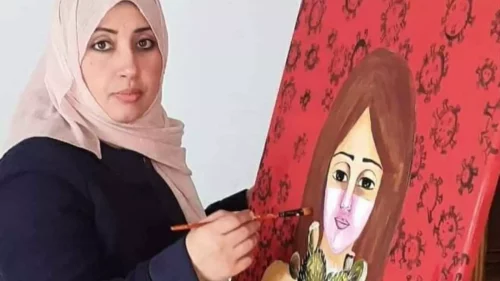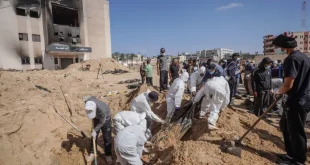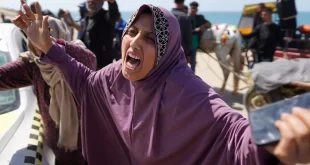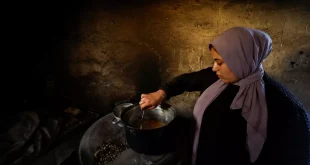
As an educator and artist she dedicated her life to documenting Palestinian heritage and history as it faced endless erasure and threat under Israeli occupation.
Her works were profound, rich in beauty and detail, often telling the spirit of the Palestinian people.
They incorporated iconic elements like Palestinian homes, farms, daily activities, shrubs and trees, mosques and churches, underscoring the need of preserving Palestinian identity in the face of adversity.
Even greater than her passion for painting, however, was her unwavering love and commitment to her family.
Born in the Al Burejj refugee camp in Gaza, Zagout grew up listening to the stories of her elders, who would routinely narrate the events leading up to the creation of Israel in 1948.
According to her sister Maysaa Ghazi, Zagout developed a love of painting from a young age.
This included telling the stories of her own family – Palestinians who were forcibly expelled from the village of Isdud, now known as the Israeli city of Ashdod, and made to seek refuge in the Gaza Strip.
In 2003, Zagout received a diploma in graphic design. Four years later, she graduated from Al-Aqsa University in Gaza, specialising in fine arts.
Shortly afterwards, she became an art teacher at a primary school in Gaza.
Follow Middle East Eye’s live coverage for the latest on the Israel-Palestine war
Zagout continued to paint, both as a means to connect the region to art lovers across the world and to help pay the bills as the sole breadwinner for her family of six.
But on 13 October her life came to a tragic end when an Israeli air strike targeted the home where she was staying, killing her and two of her four children, Adam and Mahmoud.
According to her sister Ghazi, Zagout’s husband and their two other children, Faisal and Baraa, survived.
“She used to sell the art to support her children,” Ghazi told MEE. “They [Israel] destroyed her house and everything.”
Who was Heba Zagout?
Chris Whitman-Abdelkarim, a representative of German human rights group Medico International, who came across her work two years ago, said Zagout was an artist who came of age through Instagram, developing a dedicated following around the world.
Thousands of people were intrigued by her bold, beautiful acrylic paintings that took them on a journey to Palestinian villages and towns, as well as the city of Jerusalem and the Al-Aqsa compound through the eyes of a refugee living in Gaza.
“Heba was a one in a million talent. She encapsulated everything it meant to be Palestinian and poured her heart and soul into her art,” Whitman-Abdelkarim told MEE.
“She dedicated her life to her kids and her students and she spent every waking moment helping them use art to cope with the extremely tough life in Gaza,” he added.
Likewise, Laura Albast, a Palestinian-American journalist, who was familiar with Zagout’s work and spoke to her just two days before she was killed, described her work “as very connected to her experience as Palestinian woman living in Gaza” and “a great loss”.
“This is a woman who has brought so much joy to the homes of so many people who have bought her art, who have displayed her art. It is very sad that all that remains of her work is now just on social media.
“They didn’t just bomb her home, her children, but they erased the traces of her creativity,” Albast said.
Followers of Zagout’s work said her art was not just bright, bold, warm and effervescent, the stories it carried were the very preservation of Palestinian history and experience.
For instance, in 2021, Zagout held a solo exhibition titled “My Children in Quarantine”, that focused on life during the Covid-19 pandemic.
“With her gorgeous paintings that are so lushly full of life and beauty, so full of the vibrant colours of a land she loved, so full of freedom, dreams and daily comforts, Heba Zagout refused to let the violence and ugliness of Israeli siege and blockade occupy her mind and vision,” Cynthia Franklin, from the department of English at the University of Hawai’i, told MEE.
In one painting, Zagout painted an opulent olive tree that seemed to tell a story of history, time and resilience.
“When I was young, the olive harvest season was very special to me. Family members used to gather with me and pick olives. My mother then stores them with lemon slices and peppers to keep them all year round. Thank you mom. My new artwork. Olive Tree,” Zagout wrote in the caption on Instagram.
Another painting showed a freshly pebbled roadway, flanked by shrubs and plants, leading to the city of Jerusalem.
In yet another depiction of a strong, resolute and proud Palestinian woman, Zagout painted what seemed to be a self-portrait in which she held a key to their families’ homes in Isdud.
“That the Israeli state killed this artist and her children is a register of their absolute inhumanity. What they cannot kill was her humanity, her imagination, and her art,” Franklin, from the University of Hawai’i, said.
“As her art lives on, for those of us outside Palestine who love this art and through it, the artist, may it be part of what inspires us to do everything within our means to put a stop to the genocide taking place in Gaza,” Franklin added.
In her final post on Instagram on 3 October, Zagout posted a photograph of Whitman-Abdelkarim holding an artwork with the caption: “Thank you Chris. Welcome to Gaza.”
Whitman-Abdelkarim had travelled to Gaza to return her art after an exhibition in Ramallah.
He also purchased a painting of Isdud (Ashdud) that showed different aspects of the story of her family’s village as she heard it as a child.
“It is the Isdud of her mind,” Whitman-Abdelkarim added.
The painting shows Zagout in a self-portrait, as a young, smiling Palestinian woman dressed in a black thobe with tatreez embrodiery, and draped in a white scarf, standing in front of several colourful scenes from a village.
In the caption beneath the painting, Zagout wrote: “I was born carrying the word refugee with me. I have never seen my home town, but my aunt, Alia, gathered us and told us about my grandfather’s land and the orange groves and the harvest season and a house full of love and life.”
“I saw longing in my aunt’s eyes when she told us these stories about those days in the past, and longing to return, soon. My new painting. 80 cm x 60 cm, Acrylic on canvas. Available.”
On 3 October, the painting was sold. Ten days later, she was gone.
 Sri lanka Muslims Web Portal Diversity and Inclusiveness
Sri lanka Muslims Web Portal Diversity and Inclusiveness
![Jerusalem [Heba Zagout]](https://www.middleeasteye.net/sites/default/files/Heba-Jerusalem.jpg)
![Jerusalem [Heba Zagout]](https://www.middleeasteye.net/sites/default/files/heba-jerusalem-1.jpg)
![Isdud [Heba Zagout]](https://www.middleeasteye.net/sites/default/files/HEBA-LAND.jpg)



